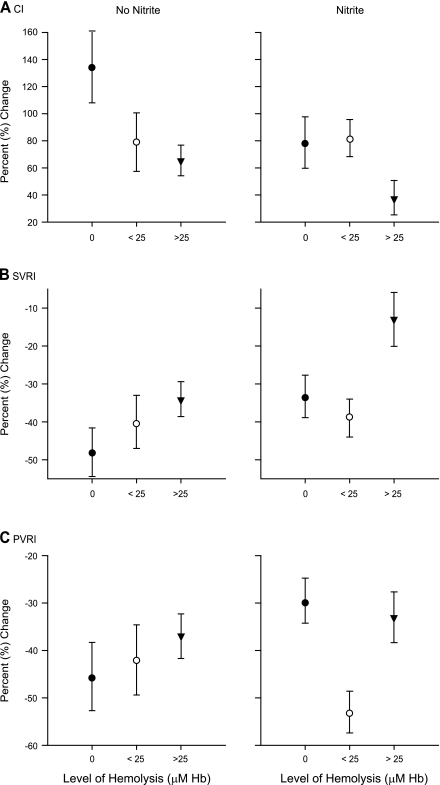Fig. 5.
Effects of nitrite and intravascular hemolysis on cardiovascular responses to sodium nitroprusside. The physiological effects of sodium nitroprusside (a direct NO donor) were dependent on the level (or dose) of hemolysis and the presence of sodium nitrite (P = 0.09, 0.05, and 0.009 for the interaction between level of hemolysis and nitrite on the effect of sodium nitroprusside for CI, SVRI, and PVRI, respectively). Depicted values represent the mean percent changes in the parameter for all doses of nitroprusside for all animals within the specified hemolysis group (0 μM, •; <25 μM, ○, and >25 μM, ▾). As expected for a direct NO donor, in animals not receiving nitrite, sodium nitroprusside-induced increases in CI and decreases in SVRI and PVRI were progressively inhibited by increasing levels of hemolysis (A–C; no nitrite). Compared with nonhemolyzing animals not receiving nitrite (zero hemolysis, no nitrite), nonhemolyzing animals receiving nitrite (zero hemolysis, nitrite) demonstrated blunted effects of sodium nitroprusside on CI, SVRI, and PVRI, suggesting a decreased vasodilator effect of donated NO in the presence of nitrite (A–C). In animals receiving nitrite, the effects of sodium nitroprusside on CI, SVRI, and PVRI were accentuated with low levels of hemolysis (Hb < 25 μM, nitrite) and attenuated with high levels of hemolysis (Hb > 25 μM, nitrite) compared nonhemolyzing animals (zero hemolysis, nitrite) (A–C; nitrite). These findings may be explained by the nitrite reduction reaction with Hb (detailed in results).

